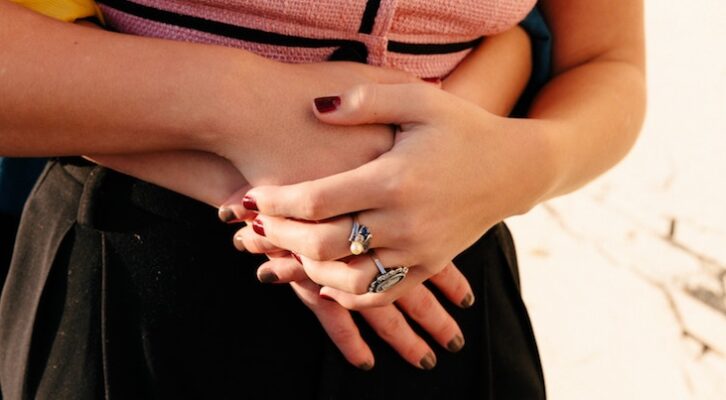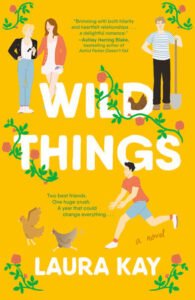
Creating Safe Spaces: On Writing Queer Romance
Laura Kay Explores the Joy of Representation in Escapism
I love having a crush. Sometimes I feel it coming like a wave, gently washing over me, a warm feeling, I bob about in it, let myself get carried away. I remember the first crush I ever had, before I even knew what the feeling was. The time dragging in long lessons without her, saving her a seat feverishly waiting for her to take it, walking home and holding hands and feeling light-headed. I understood for the first time what the novels I read meant when they talked about swooning heroines. I was positively faint with lust.
Sometimes I feel a crush coming like a flood, immediate and catastrophic. Oh no, I think, part horrified, part thrilled, you could ruin my life. I don’t even attempt to avoid it, I stand still and wait to be washed away.
I’m prone to mooning about, obsessing, fantasizing, daydreaming. I have been known to spend nights wallowing in self pity and sad girl playlists, staring at my phone and reveling in the melodrama of it all.
Part of the joy for me as a queer woman, when writing about characters falling for each other, is the shamelessness of it all—the pain and the pleasure. Because it hasn’t always felt shameless, and for a lot of queer people having a crush on someone is still something wrapped up in confusion, isolation, a necessary secrecy because of perceived or real danger. There is something deeply radical and exciting to me, about bringing into the light what is used to being kept in the dark.
I didn’t set out to write a queer rom com, in the sense that when I wrote my first novel, The Split, I wasn’t as intentional as that, assuming like most writers that no one would ever read it. I wrote about what I knew—complicated, funny, queer, twenty- and thirty-something’s muddling through life the best way they know how. I wrote what I wanted to read—a rom com with a protagonist I related to, a rom com with a love interest I fancied, with relationships I recognized, and friendship groups that made sense. Queer characters are centered and not sidelined. I took great pleasure in writing a straight best friend.
It was only when The Split was published and I started speaking about it in interviews and having readers contact me that I realized what I’d written. I’d written the book that I longed for and I was delighted to discover that I’d written a book that other queer people longed for too. I’d written a comfort read, a story that made people laugh and cry and believe in love and want to hug their friends. Readers said to me over and over again how refreshing it was to read a rom com and see themselves front and center, the star of the show. And I saw myself too, projected onto the page, surrounded by love and kindness.
I wrote what I wanted to read—a rom com with a protagonist I related to, a rom com with a love interest I fancied, with relationships I recognized, and friendship groups that made sense.
The current boom in queer romance is an exciting time for me not just as a writer, but as a reader—a fan and a die-hard romantic. I can pick up a copy of Casey McQuiston’s One Last Stop, Malina Lo’s A Scatter of Light or Lex Croucher’s Infamous in any book store and lose myself in those fun, sweet, angsty love stories. Queer people no longer have to read into subtle hints and opaque references in otherwise straight books or try to see themselves in narrow portrayals of queerness in the one book or TV show that’s broken through to the mainstream. We’re getting to a place where one queer book does not have to represent every queer person. What I wouldn’t have given for that when I was a teenager. To know I was ‘normal’ and to know I could be happy.
When I asked queer rom com readers via social media what drew them to the genre it was fascinating to see the breadth of answers, the different ways these novels have impacted them. One told me, “I think we all want to see ourselves in art, and we all want a happy ending for ourselves so seeking that out in fiction seems intuitive.” This was a sentiment echoed in a lot of the responses, “in short, we want our hobbies to reflect our needs – and queer needs at the moment are to find solace and happiness in… the wider world.”
A theme which came up over and over again when I was talking to readers was the desire to be able to relax into a story without worrying about what the queer representation is going to look like, or whether there even is any. Isabelle told me, “I think that romance/rom coms are a proper comfort read for me, but that is compromised if I spend the whole book hoping for/searching for queer characters or positive/properly researched queer rep by straight authors! Sometimes I just need an absolute guarantee before I start reading that that isn’t something I’m going to be worrying about, so that I can just properly relax into reading.”
Booksellers and librarians contacted me to tell me that the boom in queer romance indicates that publishers are recognizing that there is an audience for uplifting queer novels, that queer readers will spend money on that comfort and joy. One bookseller, Imogen in North Wales, got in touch to say that after they put up their pride display a local customer posted a note through the door to say “it helps people feel included, valued and to some degree, safer in our community.”
The LGBTQ+ community does not always have access to safe spaces. This is where the importance of queer joy in art comes into play the most. When our world is frightening, we can escape into a different one, where we can have fun and have our hearts broken and fall in love. I was mindful of this when writing my latest novel, Wild Things, in which a group of friends move out of London into a dilapidated house in a small village which they dub the “queer commune.” I’m aware that in reality, the rural English countryside may not be the most inclusive space for queer people, but in the world I create for my characters they are met with kindness and acceptance. I want readers to feel that when they’re with my characters, in my hands, they can relax. It’s a safe space.
The crushes I write in my novels now, from the office romances to the epic love stories, are for teenage me, looking for queerness on pages where there wasn’t any, searching for myself and coming up blank. Writing in diaries with locks on them. It is a beautiful thing to fall in love, sometimes for a lifetime but sometimes just for a few hours, with your head inside a book.
___________________________________

Wild Things by Laura Kay is available now via Vintage.
Laura Kay
Laura Kay is the author of Wild Things, The Split, and Tell Me Everything. She lives in East London.



















